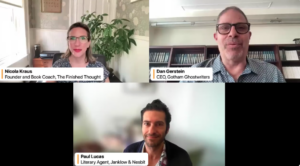
Ginny Carter is an award-winning UK book ghostwriter with a business background. She’s ghostwritten over a dozen books on a wide variety of topics, from HR to phobias. They all have this in common: they’re bringing their authors visibility, credibility, and bookability. Some of them have also been accepted by publishers such as Penguin Random House and Hachette.
Below is an excerpt from Your Business Your Book, winner of the Sales and Marketing category at the Business Book Awards 2020.
When one of my nephews was seven years old, he proudly showed me a science test he’d done at school. My attention was drawn to a question halfway down the paper: ‘Why do we have a skeleton?’
His answer was as direct as only a small boy’s can be: ‘Because otherwise we’d be a pile of skin and organs on the floor.’
Moving on from that delightful image, this is what a book outline achieves. It takes the jumble of points you want to make and turns them into a coherent and flowing set of chapters that gracefully guide your readers to your conclusion. Without this skeleton your concepts would flop about aimlessly, veering hither and thither, confusing the heck out of everyone.
This is important, because when a business book falls flat it’s rarely down to the style it’s written in or because there are a few spelling and grammatical errors along the way. It’s because it doesn’t make sense – your readers don’t ‘get’ it.
Creating your book’s outline can be fun. You almost certainly have some content swilling around already – it could be ideas and thoughts in your head, a collection of blog posts you’ve written, or the content of talks you’ve created.
There are two main ways to order your thoughts, and which one you choose depends on your personal preference.
Mind mapping
This will appeal most if you’re a visual person. Grab a sheet of paper (or use online software tools for mind mapping) and write your book’s central message in the middle, with a circle around it. Then draw a line from that and at the end of it write whatever relevant topic comes to mind first, circling that too. Your next thought might be a splinter topic of that one or another main idea that comes from the centre – it doesn’t matter what order they appear to you in, just keep scribbling them down and draw lines to and from the appropriate places.
Your sheet will end up looking like a demented spider’s web, but somewhere in it lies the beautiful skeleton of your book. Your next task is to take a step back and work out what topic your readers would want and need to know about first, second, third, and so on. Re-draw your mind map to reflect this new, more logical order.
Sticky notes
This is my personal favourite because I prefer a linear approach. Grab a colourful pile of sticky notes and jot a different topic on each one, placing them onto a white board or sheet of flip chart paper – some will be major themes and others minor points, it doesn’t matter. Don’t worry about ordering them, just dump all your ideas out.
Once all your notes are on there, see what themes emerge. Then draw columns on your board or paper with a working chapter heading for each and transfer the notes onto them by theme – you’ve made some chapters. Now you can take a fresh look to decide what order the chapters should be in, based on how helpful that order would be for your readers.
What these two processes have in common is how instinctive they are. So often I find people feel daunted by the thought of organising their material, but when they have an easy system to follow they realise they know how to do it already. The outline just needs some help with being born.
Your book category
Now you know what you want to say and in what order, you need to create a table of contents. To do this it’s helpful to know there are four main categories of business book, each with its own top-level outline.
– Self-help or how-to guide, such as Will it Fly? by Pat Flynn.
– Transformational memoir (your story and how your readers can learn from it), such as Option B by Sheryl Sandberg and Adam Grant.
– Thought-leading, inspirational book, such as A Good Time to be a Girl by Helena Morrissey.
– Collection of interviews, such as the final section of Public Speaking for Authors, Creatives, and other Introverts by Joanna Penn.
What type of book do you want to write? Let’s look at each to help you decide; even if you’ve already picked a format you may find yourself changing your mind once you’ve been through them.
Self-help or how-to guide
This is a stalwart of nonfiction books, and is an excellent vehicle for showcasing your expertise and experience. If you’re a coach or consultant, it both gives you the opportunity to prove what you know and also offers your readers a low risk way to become familiar with your ideas. As such it’s also a great option if you have a programme or service you’d like to turn into a book, as you’ll gain a whole new audience for it.
This type of guide is a step-by-step process for helping your readers travel from a place of uncertainty to one of knowing, using your expertise and experience to get them there. They may be feeling vulnerable and confused, or even just looking for an improvement to their current situation. Either way, they’ll appreciate you taking them by the hand and leading them gently through the process of change in a logical and straightforward way.
If you want to use your book to raise sales of your programme, it’s a good idea to order your content in the same way so there’s a seamless join between the two.
Introduction: describe your readers’ problem, including how it’s manifested in their lives, and empathise with them. Maybe you had the same issue yourself in the past. Explain briefly how you’re going to help them solve it in this book, and convince them that you’re someone to trust by showcasing your credentials.
Chapter One: lay the groundwork. This consists of the underlying principles your readers should understand before they take their first improving step (you might need more than one chapter for this).
Chapter Two +: take your readers through a step-by-step process for overcoming their problem, with each major step having its own chapter. Include action points, examples, and possibly exercises.
Conclusion: summarise what your readers have learned, and encourage them to put their new knowledge into action. Look to the future and describe how their lives will be different now they’ve read your book.
Transformational memoir
In this category of book you tell your own story of personal transformation, helping your readers to learn from your experience. You can either relate your story chronologically or split it into themes and ideas – both routes are valid. This can be a powerful way of putting across your message, but the mistake many authors make is not to ensure that their story is completely relevant to their readers. By following this top-level outline you’ll avoid this trap.
If you’re not sure what elements of of your story to include, try this exercise. Take a sheet of paper and divide it lengthways. List the main points of your story on the left and the lessons you want to impart on the right. Then draw lines between the two lists to match them up, the result of which will give you a solid starting point for your book outline.
You’ll find it helpful to read other transformational memoirs and see how they’ve created an interesting and useful read, choosing the techniques you find most relevant and incorporating them into your own. Deciding how to tell your story, and weaving the most relevant parts of it into your book as you impart lessons to your readers, isn’t an easy process. If you don’t enjoy storytelling and find writing narrative hard work, this may not be the best format for you.
Introduction: give your readers an incentive to read your book, with a taster of your story and a preview of what they’ll learn from it. How is it relevant to them? What will they gain from it? This is a good place to bring out your personality so your audience starts to get to know you.
Chapter One: what was your life like when your story began? You could begin before your transformation started (to set the scene), at the beginning of the process, or even at the end.
Chapter Two +: the stages of your story along with the learning points for your readers. One of these chapters should detail your lowest moment and then your turning point – how you realised where you’d been going wrong and what you did to put it right. This is another place you can start your story, because it may be the place your readers are at now.
Conclusion: where you are today and how your readers can gain inspiration from this. An overview of what to do next is also helpful.
Thought-leading, inspirational book
This is an excellent type of book for highlighting the quality and originality of your thinking, and is especially popular with speakers wanting to further their paid speaking careers, or with consultants needing to raise their credibility. It’s also highly satisfying to write: how often do we have the chance to expound our ideas, going into them in depth and bringing them to life with examples?
This kind of book can also contain an element of ‘how-to’, as well as incorporating your personal story. Because of this flexibility it’s a more difficult category to provide a standard structure for; however, there are still some principles you can apply.
Introduction: your reader has a burning curiosity or concern – that’s why they want to learn about your take on it. So empathise with them and explain briefly how you’re going to inspire them in your book. Share your credentials (why should they listen to you?), which should include your own experiences in this area.
Chapter One: go through the background to your topic. Why is it important? And why now? Have you had personal experience with it, and how has that affected your outlook?
Chapter Two +: each element of your subject matter should have its own chapter. You can break it down in various ways: by the different aspects of it that link to your central thesis, by the action you want your readers to take, by chronology, or by importance.
Conclusion: end on a rousing note – this is your final chance to impress the relevance of this subject upon your readers and encourage them to take action (if that’s your aim).
Collection of interviews
This is a useful style of book if you enjoy talking to people, especially as it makes compiling your content relatively easy. It also allows you to appear on the radar of, and develop closer relationships with, influencers in your field, which is ideal for promoting your book and building your business profile.
However, please don’t think that all it involves is transcribing some conversations and putting them in a book – you need to make the topic compelling and meaningful. One drawback of this format is that although it might seem like a good idea to gain your content from others, it does mean you’re not the ‘star’ of your book – this has implications if you want it to build your authority.
An obvious format is to create a new chapter for each interview, but you can have themed chapters instead in which you talk about what you’ve learned and give examples from various interviewees. For instance, if you’ve interviewed various finance experts about how to save money, you might want to take a themed approach as many of them would give similar advice. But if you’re interviewing people who have different areas of expertise around a central theme, such as medical professionals talking about mental health, then a chapter per interviewee could work well.
Introduction: what will your readers learn from this book – what’s in it for them? What problem do they want to solve? And briefly, what are the credentials of the interviewees and how did you come to meet them (there might be an interesting story here)?
Chapter One+: each interview or theme has its own chapter, with your introduction and summary topping and tailing them.
Summary: what have your readers learned? Make the points clear for them, as the nature of interviews means they may have been obscured at various points during the book.
Conclusion: what have your readers learned, and what should they do next?
You’ll notice these four outline types can overlap: your interview book might contain how-to elements, your how-to guide might contain some of your personal story, and your thought-leading book could include interviews with other thinkers on your topic. So don’t feel you have to be rigid with your outline type, just consider what the main thrust of your book will be and use these formats as a guide.
The book outline you choose should be connected to the purpose of your book. What do you want your readers to think, feel, and do by the end of it, and which of these is most important? If you want them to do something, a how-to guide might be best. If you’re keen for them to think something, an inspirational book would work well. And if you’re prompting them to feel something, a memoir or story-based approach could be the answer.
Are you still stuck? Turn to your bookcase or e-reader and glance through the books you’ve read recently. Which were most helpful and enjoyable for you? Take a look at how they’re structured and you’ll find clues to the kind of book you want to write.
You can also think of your readers. What kind of book would they appreciate? You can gain a feel for this from your reader avatar; think about the kind of person they are, when they’ll fit the reading of it into their lives, and what you’d like them to do, think, or feel once they’ve finished it. Which outline would suit them best?
Do you have a story idea? Pitch it to us below, and we’ll work to match you with a writer who can help you bring your vision to life.
Author
-
Ginny Carter is a business book ghostwriter, book writing coach, and author. She’s on a mission to transform entrepreneurs, coaches, and consultants from everyday experts into respected thought leaders and in-demand speakers, through the book that grows their reputation and expands their business.
View all posts



